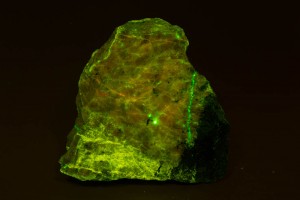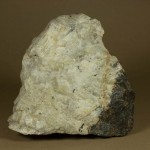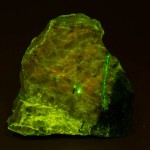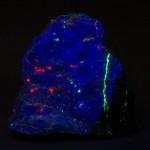Mineral fluorescence under blue light – hardystonite
Posted On: Friday, March 13, 2015

The geology community knows a lot about mineral fluorescence under excitation by various wavelengths of ultraviolet light but when it comes to excitation by light in the visible portion of the spectrum, such as blue, … not so much. In December 2013 Charles Mazel (NIGHTSEA) and Earl Verbeek (Sterling Hill Mining Museum) explored the extensive collection of the Franklin Mineral Museum (Franklin, New Jersey, USA) for instances of blue-light-stimulated fluorescence. When fluorescence occurred the specimen was photographed under white light, fluorescing under blue light, and fluorescing under either or both of shortwave and longwave ultraviolet light. The results were published in September 2014 – Mazel, C.H. and Verbeek, E.R. (2014), Fluorescence of minerals under blue light. The Picking Table (Journal of the Franklin-Ogdensburg Mineralogical Society), vol. 55, no. 2, p. 13-25.
We will share the photographic results in a series of blog posts, each documenting one specimen. See the summary of all posts to date.
The editors of The Picking Table have graciously allowed us to make the fall 2014 issue with our article on blue light mineral fluorescence available for free download. Click the image of the cover to access the pdf. And we certainly encourage you to join FOMS so that you can keep up with their activities and receive future issues.
Mineral (primary) – Hardystonite
Specimen identifier – SC79
Approximate size (cm) – 13 x 13 x 10
Appearance –
White light – Gray mass is hardystonite. Black at lower right is nonfluorescent franklinite ore. Willemite vein shows as faint brown line. Grains of calcite are also present but are nearly the same color as the hardystonite.
Blue light – fluorescence: Mottled/streaky orange to yellow is hardystonite. Thin vertical green vein near right edge is willemite
Shortwave ultraviolet – fluorescence: Deep violet is hardystonite; thin vertical green vein near right edge is willemite; red grains are calcite.
Longwave ultraviolet – hardystonite is non-fluorescent (no picture taken)
(Click on image for larger view)
- White light
- Blue light
- Shortwave ultraviolet light




